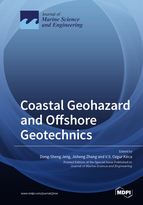Coastal Geohazard and Offshore Geotechnics
A special issue of Journal of Marine Science and Engineering (ISSN 2077-1312).
Deadline for manuscript submissions: closed (1 April 2019) | Viewed by 69070
Special Issue Editors
Interests: offshore geotechnics; ocean engineering; coastal groundwater hydraulics; offshore wind energy
Special Issues, Collections and Topics in MDPI journals
Interests: offshore geotechnics; coastal engineering; tidal stream energy
Interests: offshore geotechnics; coastal engineering; seabed–structure interaction; marine renewable energy
Special Issue Information
Dear Colleagues,
With the rapid development in the exploration of marine resources, coastal geohazard and offshore geotechnics have attracted a great deal of attention from coastal geotechnical engineers and has achieved significant progress in recent years. The purpose of this Special Issue is to present recent advances in the field of coastal geohazard and offshore geotechnics. Authors are encouraged to submit theoretical, numerical, experimental, and applied articles addressing this theme. Topics include, but are not limited to, the following research topics:
- fluid–soil–structure interactions around marine infrastructure;
- seismic-induced seabed liquefaction;
- scour around marine structures;
- effects of tsunamis on seabed soil;
- marine geology;
- soil characteristics and constitutive model for marine sediments;
- Sediment re-suspension and transport in coastal estuarine
- centrifugal modelling for geohazard and offshore geotechnics;
- geohazard prediction and protection;
- challenges and novel methods in offshore foundation design.;
- submarine landslide;
- impact of climate change on geohazard.
Prof. Dr. Dong-Sheng Jeng
Prof. Dr. Jisheng Zhang
Assoc. Prof. Dr. V.S. Ozgur Kirca
Guest Editors
Manuscript Submission Information
Manuscripts should be submitted online at www.mdpi.com by registering and logging in to this website. Once you are registered, click here to go to the submission form. Manuscripts can be submitted until the deadline. All submissions that pass pre-check are peer-reviewed. Accepted papers will be published continuously in the journal (as soon as accepted) and will be listed together on the special issue website. Research articles, review articles as well as short communications are invited. For planned papers, a title and short abstract (about 100 words) can be sent to the Editorial Office for announcement on this website.
Submitted manuscripts should not have been published previously, nor be under consideration for publication elsewhere (except conference proceedings papers). All manuscripts are thoroughly refereed through a single-blind peer-review process. A guide for authors and other relevant information for submission of manuscripts is available on the Instructions for Authors page. Journal of Marine Science and Engineering is an international peer-reviewed open access monthly journal published by MDPI.
Please visit the Instructions for Authors page before submitting a manuscript. The Article Processing Charge (APC) for publication in this open access journal is 2600 CHF (Swiss Francs). Submitted papers should be well formatted and use good English. Authors may use MDPI's English editing service prior to publication or during author revisions.
Keywords
- seabed instability
- fluid-soil-structure interactions
- coastal dynamics
- coastal disaster
- soil constitutive model
- liquefaction
- scour
- submarine landslide
- marine geology







